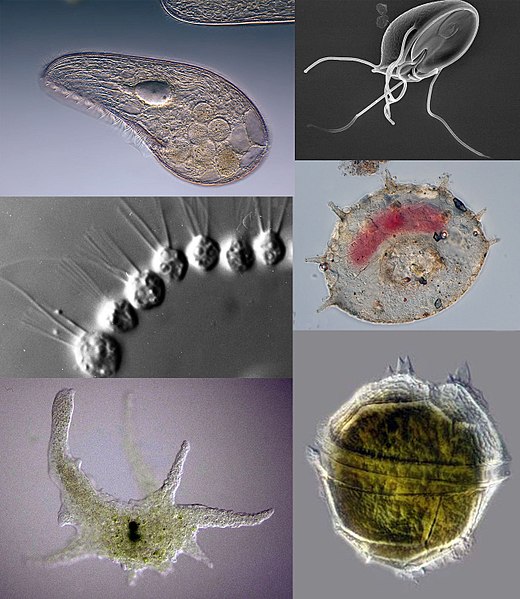Difference Between Algae and Protozoa
Table of Contents
The key difference between algae and protozoa is that algae are autotrophic plant-like eukaryotes while protozoa are heterotrophic animal-like eukaryotes that belong to kingdom Protista.
There are five major kingdoms that classify all living organisms based on 3 criteria: cellular organization, arrangement of cells, and type of nutrition. They are Kingdom Monera, Protista, Fungi, Plantae and Animalia. The cellular organization indicates whether they are eukaryotic or prokaryotic. Cell arrangement describes whether they are unicellular, multicellular, with or without true tissue differentiation, etc. Type of nutrition explains whether they are autotrophic or heterotrophic. Algae and protozoa are two major categories of organisms that belong to Kingdom Protista.
CONTENTS
1. Overview and Key Difference
2. What are Algae
3. What are Protozoa
4. Similarities Between Algae and Protozoa
5. Side by Side Comparison – Algae vs Protozoa in Tabular Form
6. Summary
What are Algae?
Algae are a large group of organisms that are of high biological importance. They are often photosynthetic eukaryotes living in the water. Algae live in both marine and fresh water. They lack true stems, leaves or roots. Therefore, their body looks like a thallus.

Figure 01: Algae
There are different phyla of algae based on the type of their photosynthetic pigments. These include phylum Chlorophyta, which includes green algae, phylum Phaeophyta, which includes brown algae, phylum Rhodophyta, which includes red algae, and phylum Bacillariophyta, which includes diatoms. All these phyla have some general characteristics in common. In addition, almost all are well-adapted to life in water. Furthermore, there is a large diversity among these members in terms of size and form. They include unicellular, filamentous, colonial, and thalloid forms.
What are Protozoa?
Protozoans are animal-like eukaryotes belonging to kingdom Protista. Unlike algae, they lack a cell wall and are heterotrophs. The organisms are always unicellular. One common example of a protozoan is Amoeba. Amoeba is aquatic, free-living and omnivorous protozoan. Furthermore, the cytoplasm of protozoans has two distinct regions: an outer ectoplasm and an inner endoplasm. They are also uni-nucleated. The endoplasm contains fat droplets as food vacuoles, contractile vacuoles for osmotic regulation and various vacuoles or crystals containing excretory material. However, it does not have a definite shape. It constantly produces temporary out-pushings of the cytoplasm called pseudopodia. Pseudopodia help in locomotion and feeding.

Figure 02: Protozoans
Paramecium is an aquatic amoeba seen in fresh water. Its body is in the shape of the sole of a slipper. Also, it is unicellular but consists one large (meganucleus) and one small nucleus (micronucleus). A thin, flexible pellicle covers the cell. Moreover, the pellicle has a large number of cilia, which help in locomotion. There are 2 fixed contractile vacuoles at the anterior and posterior end. It takes in food particles from a ciliated shallow depression on the ventral surface called the oral groove, which extends to a narrow tube-like gullet.
What are the Similarities Between Algae and Protozoa?
- Both algae and protozoa belong to kingdom Protista.
- They are eukaryotic organisms; hence, they contain a nucleus and membrane-bound organelles.
- Also, both groups include unicellular organisms.
- Moreover, they live in aquatic habitats.
- Organisms in both groups also possess flagella.
- Besides, they use mitosis as a mode of reproduction.
What is the Difference Between Algae and Protozoa?
Algae are unicellular or multicellular autotrophic plant-like organisms while protozoans are unicellular, heterotrophic animal-like organisms. So, this is the key difference between algae and protozoa. Furthermore, algae produce their own foods by photosynthesis while protozoa ingest foods by phagocytosis. Moreover, algae contain chlorophylls and a cell wall composed of cellulose while protozoa lack both chlorophyll and cell wall. Therefore, this is also a major difference between algae and protozoa.
Below infographic on the difference between algae and protozoa shows more comparisons.

Summary – Algae vs Protozoa
In brief, algae and protozoa are the two main categories belonging to the Kingdom Protista. They are mostly unicellular and aquatic. In summarizing the difference between algae and protozoa, algae are plant-like organisms that are capable of photosynthesizing while protozoa are unicellular animal-like organisms that are heterotrophs. Algae contribute to global oxygen production while protozoa cause diseases to human.
Reference:
1. Vidyasagar, Aparna. “What Are Algae?” LiveScience, Purch, 4 June 2016, Available here.
Image Courtesy:
1. “Algae Algonquin” By Mykola Swarnyk – Own work (CC BY-SA 3.0) via Commons Wikimedia
2. “Protozoa collage 2” By Collage – Frank Fox, Sergey Karpov, CDC/ Dr. Stan Erlandsen, Picturepest, Thierry Arnet, dr.Tsukii Yuuji – derived from:Mikrofoto.de-Blepharisma japonicum 15.jpgDesmarella moniliformis.jpgGiardia muris trophozoite SEM 11643.jpgPeridinium willei – 400x – Dinoflagellate (15058894916).jpgCollection Penard MHNG Specimen 88-4-3 Centropyxis aculeata.tifChaos carolinense.jpg (CC BY-SA 4.0) via Commons Wikimedia
ncG1vNJzZmivp6x7pbXFn5yrnZ6YsqOx07CcnqZemLyue8OinZ%2Bdopq7pLGMm5ytr5Wau26ty6CYnmWRo7FuwtJmp6unpKTHsK2O